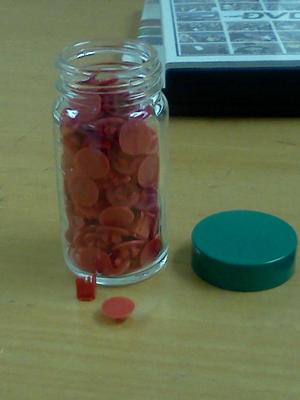This is the second of two posts on our conservators’ work with the Smithsonian’s Haiti Cultural Recovery project. This post is an excerpt from the forthcoming publication by Dr. Richard Kurin, Saving Haiti’s Heritage: Cultural Recovery After the Earthquake. Translated as: Sovtaj Patrimwàn Kiltirèl Ayiti: Prezève kilti aprè tranblemann tè a (Haitian Kreyol) and Sauvetage du Patrimoine d’Haïti: préservation de la Culture après le séisme (French) Smithsonian Institution: 2011. (ISBN-13 9780966552003)
In June 2011, I was in Haiti as part of the Smithsonian Institution’s Cultural Recovery activities, to talk to broadcasters and audiovisual librarians about their collections in the aftermath of the 2010 earthquake. Haiti is not alone in having a preservation crisis when it comes to audio-visual heritage. Archives and libraries throughout the world have declared that film, video, and audio collections are deteriorating so rapidly that a vast record of human experience from the 20th century is disappearing. The question for me as I toured television and radio stations in Port-au-Prince was how much remained after the earthquake.

The good news is that many historic recordings are kept by the broadcasters; the bad news is that circumstances keep these recordings from being used and preserved. In cramped air-conditioned studios, producers are creating content on contemporary broadcast formats; but on the shelves in small side offices there are thousands of rare LP records and analog audio and videotape recordings waiting to be resurrected.
At Radio Lumiere a friendly electronics engineer showed me audio decks that he had fixed in his immaculate workshop, using his special skills and almost-obsolete parts specially secured from the United States. In another corner, there was a pile of equipment that were still awaiting parts.
In the TV control room at Radio Métropole the staff held a lively conversation about how more and more broadcast technology is digital, and the old equipment that they use is being slowly replaced. Being behind the technology curve is not always a bad thing when trendy technologies decline in price over the course of a year, but the cost of even five year old technology is often beyond the capability of poor broadcasting stations. The result is that the overall media content for these broadcasters is stuck in the 1990s and earlier.
On the staff patio at Radio Antilles Internationale with a mango tree dropping its ripe fruit just a few feet away, we delved into the concerns of cataloguing the sounds and sights contained on fragile magnetic media. Access to expertise in the library and archives field is infrequent, so some of the most cost-effective and efficient means of capturing data and making it accessible via the web has not come to Haiti.

On my second to last day in Haiti I led a group of broadcast professionals in a custodial exercise at the National Television of Haiti (TNH). The TNH library contains over ten thousand hours of political talk-shows and newscasts that cover the tumultuous years of the 1970s, ‘80s, and ‘90s. These tapes are all on a now-obsolete format called ¾”-U-matic, and I did not see one working U-matic deck in Haiti. The tapes—censored by technology—may be the documentation that propels democratization in a country that has seen so much manmade and natural disaster.
Twenty colleagues and I spent an afternoon wiping off dust and grime from over five hundred vintage political tapes and removing the red “record buttons” from the tapes that will prevent them from being accidentally erased when they are placed into a playback deck. Afterwards, we celebrated a worthwhile accomplishment in the television’s canteen with delicious Haitian coffee and Prestige beer. One thing that Haiti does not have a shortage of, it seems, is collegiality and good will among professionals.
Produced by the Smithsonian Institution Archives. For copyright questions, please see the Terms of Use.

Leave a Comment